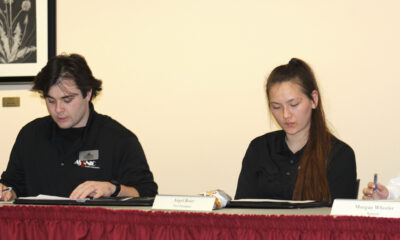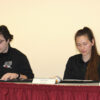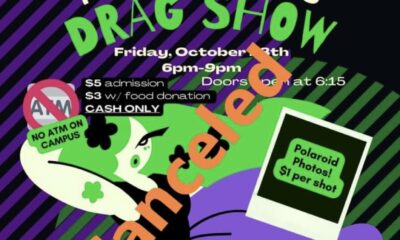Uncategorized
Tobacco free: Mixed feelings surround NIC’s new smoking policy
NIC is keeping up trends with other colleges and universities across the nation by becoming a tobacco-free campus.
The guidelines, passed through college senate by President Priscilla Bell, went into effect July 1 and were prompted by an ASNIC survey.
ASNIC Vice President Nick Dimico said the majority of students polled last spring was against the use of tobacco products on campus.
“They wanted to see smoke go,” he said.
Dean of Students Linda Michal said, “For years faculty, staff and students complained they couldn’t walk across campus without smoke in their faces.”
According to the written guidelines, the purpose of this ban is to reduce harm from second-hand smoke, provide an environment that encourages individuals to be tobacco-free and establish a college culture of wellness.
“The real message was not meant to be punitive to smokers,” Michal said. “It was not meant to be mean or nasty.”
Dimico said once the ball started rolling, students naturally became upset.
“I think it’s stupid,” said Brian Morgan, Priest River, diesel mechanic. “I think we can make our own decisions. If you don’t like the smoke, don’t stand around it.”
“The initial plan was to help people know their resources and how to quit,” Michal said. She said cards with listed resources to help curb smoking are being passed out, as well as maps regarding the boundaries of the campus.
“The simple act of a non-smoking campus is not enough unless counselors and workshops are provided to motivate individuals to quit,” said psychology instructor Victor Duarte.
Michal said that she is working with students by looking into health services, community services and nicotine replacement therapy.
“Clearly the ban is a reflection of a wider change of norms in our society,” said sociology instructor Jeff Stotik. He said he feels the guidelines are “extreme” but understands there should be restrictions and regulations.
“It is a good public health approach, but I don’t think it was well thought through,” he said.
“Anytime there is a new rule it creates a class of deviant people,” Stotik said. “A large number of students smoke, and I’m wondering if a compromise couldn’t be reached.”
Dimico said designated smoking areas became a hassle because of their close proximity to campus buildings.
“I feel people have rights, but health concerns are important,” he said.
There was conversation about building huts to try to confine smokers, Michal said, but it proved ineffective in usefulness and really combating the problem.
“It’s nice walking outdoors and not having to breathe in second-hand smoke,” said Rob Baker, Salmon, Idaho, culinary arts.
“There has been a proven correlation between second-hand smoke and health risks,” Duarte said. “It’s not a tremendous hindrance for students to just go off campus and smoke.”
Smoker Jeffrey Nordin, Coeur d’Alene, applied science, said it’s not like he can’t spend five minutes walking off campus to go smoke.
“They don’t want you to smoke here, and I’m OK with that,” he said.
Smoker Charles Clemmons, Coeur d’Alene, social work, had a different outlook.
“I won’t comply,” he said. “It’s not a choice of NIC to dictate when and where I smoke. It’s an act of violence and a violation of our rights.”
He added that he plans on starting a petition.
“I understand nicotine is a very significant addiction and not an easy one to break,” Michal said. “It is a terrible health consequence and we want to support people in doing that, but they certainly have the right to protest.”
Since the guidelines went into effect, Michal said she personally has noticed people not smoking as much. She even said she got an apology from one young man who was caught in the act.
“There was no angry response, no ‘what the hell are you doing?’” she said.
Grace Stamsos, Coeur d’Alene, political science pre-law, indicated however that one quick cigarette break near the buildings eventually led to a group of others joining in. They even nicknamed themselves “the dirty rotten smokers club.”
“If I were caught, I would politely put out my cigarette then light back up when the enforcer left,” she said.
“I grew up around it,” said Bubba Hansen, Post Falls, physical therapy, “but I’m an athlete so I try to stay away from it.”
Students seem to be split on a class level, Stotik said.
“They vary where they are in terms of a desire to quit,” Duarte said. In respect to a program like this, he said, we need actual data.
Kaitlin Henderson, Coeur d’Alene, general studies, said she feels good about the guidelines.
“Last year, everywhere I walked I had to breathe in smoke, and I’m not a fan,” she said. She also thought it would only curb tobacco use dependent upon how set smokers are in their ways.
Some students are angry, but a lot want to quit, Michal said.
“A simple inconvenience can help increase the motivation.”
“I hope it stays intact for a healthier campus,” Dimico said. “I also hope we can work around the kinks and find ways to connect with those opposed to it.
NIC is enforcing the tobacco-free guidelines by word of mouth and through courtesy tickets, he said.
The guidelines indicate student leaders, administrators, staff and college security all have the capacity to issue violations.
Because it’s on private property, NIC also has the right to enforce the guidelines in privately owned vehicles, just as with alcohol or drugs, Michal said.
At the end of the year, everything will be reviewed, Dimico said. He said tobacco-free is really important, but it’s also important that ASNIC succeeds with all of the students.
The guidelines suggest if the program is viable, manageable and enforceable, it may be reconsidered as a potential college policy.
Michal said that at this point, there is more significant disciplinary action if the smoker is verbally abusive or threatening when confronted.
Clemmons said he is just waiting for a warning so he can take it to court.
There must be more investment on the part of everyone, Duarte said. It would be good for schools to do research to see if it is actually helping, he said.
It seems reasonable that more campuses get on board because the prediction is that all campuses will be smoke-free in the future, he said.
Tobacco is defined as any type of tobacco product including but not limited to cigarettes, cigars, cigarillos, electronic cigarettes, pipes, hookahs, smokeless or spit tobacco or snuff/snus.
Next month, more information will be coming forward, Michal said. NIC is looking at a cessation program and reviewing the cost measures.
“We have a lot of education to do,” she said. “It’s not just a security function. Our intention is to help students understand and create a healthy environment for everyone.”








